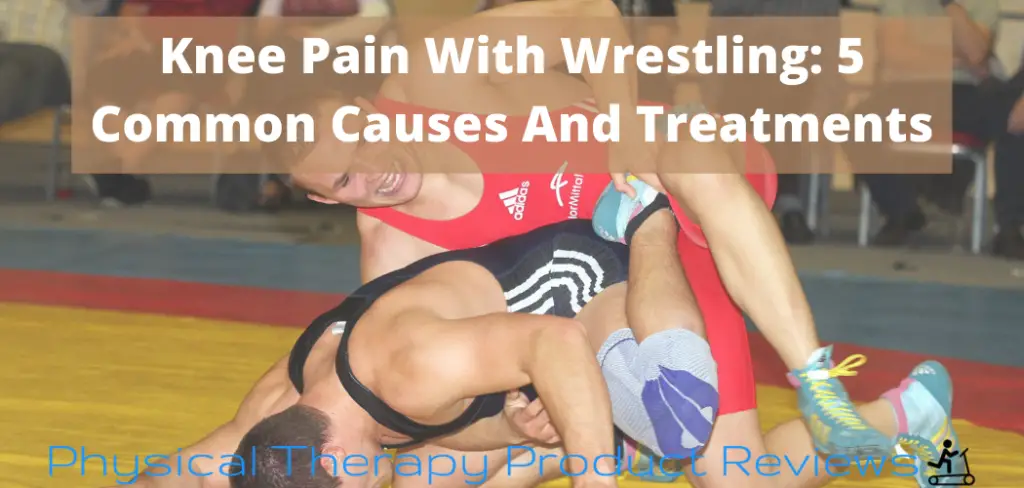Are you a wrestler with knee pain? Are you surprised that getting slammed onto the ground might cause knee pain? All kidding aside, the knees can take a pounding in a normal wrestling match and throughout the whole season.
We don’t want you to miss any of your season due to a pesky knee injury. It’s never fun to sit on the sidelines nursing along with a bum knee. In the literature, there were 11.5 knee injuries per 100 wrestlers per year requiring a week or greater time loss.

Knee pain with wrestling is a common issue that can be caused by a variety of factors. In this article, we will discuss knee pain with wrestling and what you need to know about it. We’ll cover typical knee injuries, knee rehabilitation, knee braces for wrestlers as well as give some great tips on how to avoid knee pain in the future!
Common Knee Injuries in Wrestling
Knee injuries are common in wrestling, it’s a simple fact of the sport and part of the gig. We’ll review the most common injuries, help you differentiate the different diagnoses, and provide additional resources to help speed up the recovery.
Meniscus Tear
The most common knee injury in wrestling is a meniscus tear. The medial and lateral menisci are C-shaped pieces of cartilage that act as shock absorbers between the Femur and Tibia bones.
They are typically injured when the knee is bent and twisted, such as when you’re taken down to the mat. Symptoms of knee pain with wrestling include knee swelling, knee tenderness along the joint line of the knee, and occasionally a “popping” or “tearing” sensation.
In wrestling, there is a greater incidence of lateral meniscus tears than medial meniscus tears.
After the initial injury, there is mild pain and swelling with walking but it is most noticeable during single-leg activities such as stairs, kneeling, and squatting.
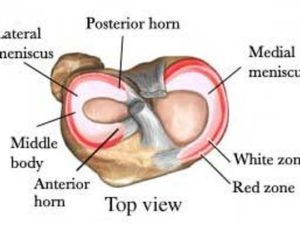
If your knee locks and feels like it gets stuck after your initial injury, this can be problematic. The Meniscus can tear and flip, causing the knee to mechanically lock. In these instances, you may need surgery to clean up the torn pieces of the Meniscus.
Expected time off from Injury: 2-6 weeks depending on the severity of the injury
Related Topic: Best Knee Braces for a Meniscus Tear
Patellofemoral Pain Syndrome/Runner’s Knee
Another knee condition that is common with wrestling is Patellofemoral Pain Syndrome. The knee cap has a slick underside which allows it to glide smoothly against the thigh bone during motion. The knee cap and surrounding tissue become irritated from repetitive force
However, if there are changes in the positioning of the knee cap, knee pain may occur. This is more common in women and adolescents as their bones are still growing but can often cause knee pain with wrestling.
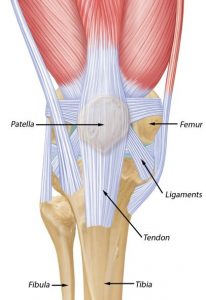
Symptoms of knee problems involving the kneecap include discomfort during squats or stairs where you feel a grinding sensation beneath your knee cap, swelling around the knee, or pain with kneeling after extended periods of sitting.
Patellofemoral Pain Syndrome is treated with a combination of knee stretches, strengthening the hip and quad, and physical therapy.
Expected time off from Injury: 1-3 weeks depending on the injury
Related Topic: The Best Knee Brace for Patella Stabilization
Ligamentous Injuries in Wrestling
Knee ligament injuries are less common with wrestling but can still occur. These knee problems typically result from a direct blow to the knee or significant force on the knee during twisting motions.
There may be a “pop” felt and considerable swelling of the knee after the injury. A common complaint after a ligamentous injury is the feeling that the knee is going to give out and collapse.
The most common ligament injuries during wrestling involve the ACL but the MCL and LCL ligaments can also be injured during a wrestling match.
Symptoms of a ligament injury include swelling, stiffness, and feeling of instability in certain positions. Knee braces can be very helpful in preventing further injury and speeding up the healing process.
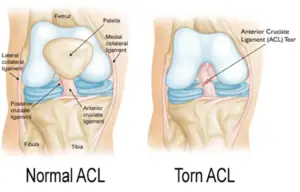
Most ACL injuries do require surgery to repair the torn ligament but this may have to happen after the season depending on the age and severity of the injury.
Treatment of ligament knee pain usually involves a combination of rest, ice, compression, and elevation (RICE), as well as physical therapy.
Expected time off from Injury: 4-12 weeks depending on the severity of the injury
Related Topic: The Best Exercises to Prevent ACL Injuries
Patella Dislocation
The knee cap, or patella, can dislocate from the groove in which it sits on the Femur. This is more common in adolescents and young adults as their bones are still growing. The knee pain with wrestling may be sudden and severe and accompanied by a “pop” sound.
There is usually significant swelling of the knee and bruising around the knee cap. In cases of traumatic patella dislocation with wrestling, you may notice that the knee cap will not sit in its normal position when applying pressure to it from the side or front of your knee.
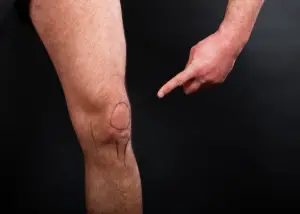
In these instances, it is best to go see a doctor as this could lead to a more serious problem if not treated.
A patella dislocation can be treated through knee braces, physical therapy, and in certain situations may require surgery.
Expected time off from Injury: 6-12 weeks depending on the injury
Related Topic: The Best Knee Brace for Patella Tracking/Dislocation Prevention
Patellar Bursitis
Pre-patellar bursitis is a knee condition that causes swelling under and on top of the knee cap. This can be common in individuals with poor form when performing squats and with landing on their knees in a bent position. This is especially common in wrestling pressure is put on this area of your knee.
It may also occur from overuse or repetitive movements, such as wrestling takedowns where you are constantly landing on your knee.
The knee pain will be localized under or over the kneecap and worsen with activity. You may also have swelling, redness, and warmth in the area.
Pre-patellar bursitis is treated with a combination of rest, ice, compression, and elevation (RICE), as well as physical therapy.
These types of injuries respond well to compression knee braces to help manage the swelling and support the knee.
Expected time off from Injury: 2-4 weeks depending on the injury
Related Topics: Best knee compression sleeve for Patella Bursitis
Is Wrestling Bad for Your Knees?
While knee pain with wrestling is certainly something you want to avoid, there are ways to lessen your risk. Proper knee bracing and strengthening the surrounding muscles will help reduce injuries during wrestling.
There’s no need to stop wrestling completely due to knee problems but it may be time to consider a knee brace or two in order to protect this vulnerable joint.
A knee brace that provides compression and support for the knee joint will help reduce knee pain with wrestling, accelerate recovery time of injuries, and provide proper alignment to keep you on your feet.
Wrestling is a fantastic sport but knee problems can certainly sideline someone from participation in this activity due to knee pain associated with it so choose a knee brace that will help you perform at your best and prevent knee pain during wrestling activity.
Knee Brace Options for Wrestling
There are many different knee braces that can work well with wrestling and depends on your needs for your situation.
For example, a simple knee compression sleeve works great for mild knee injuries such as bursitis and patella tracking issues. We recommend the shock doctor knee compression sleeve for these types of issues.
For a knee brace with a little extra padding but still have the compression and support that the knee brace provides then we like the Bauerfiend Genu Train knee brace.
For more serious injuries you may have to wear a hinged knee brace. This type of knee brace will provide more support and stability for the knee joint. A great knee brace for this situation is the Donjoy Performance Bionic knee brace.
Why You Should Trust Us Regarding Bracing
We understand knee braces and the importance of having the right knee brace for wrestling. Our team of Physical Therapists has years of experience in providing treatment and medical support knee to athletes of all levels, including recreational and collegiate wrestlers.
We understand the demands of the sport and the issues that arise from the different types of knee injuries. We also know knee braces and their importance in knee injury prevention.
We hope this article helps you make the decision to try wearing a knee brace when wrestling or if it is time for the replacement of your current knee brace! Please let us know what type of knee brace has worked well for you in the comments below.
Tips for Reducing Knee Injuries with Wrestling
The most common times for injuries in wrestling occurred during takedowns and on the down the wrestler.
Knee injuries are more common in the defensive wrestler than in the attacking wrestler.
So if you can be on the offensive then you can avoid being injured.
Just kidding but being taken down at the knee with it planted can put it at risk of injury.
Other tips to decrease knee injuries with wrestling:
- Wear a knee brace that offers compression and support for the knee joint
- Strengthen the surrounding muscles to improve stability with wrestling
- Take time for care after the wrestling mactch. This includes foam rolling, stretches, ice for acute injuries, and heat for soft tissue injuries
- Be the aggressor. Most of the knee injuries occurred in wrestlers that were on the defense and on the bottom.
Conclusion
Knee pain is a common problem in wrestlers. The twisting, landing, and direct weight bearing on the knee can cause an increased risk of injury. We’ve reviewed the 5 most common causes of knee pain with wrestling and provided some tips on how to treat those injuries. In addition, we hope that you found our tips to be helpful in reducing the risk of knee pain.
Other Great Rehab Related Articles
How to Stay Active After Cervical Fractures: Expert Tips and Advice
Dealing with Painful Stairs After Ankle Replacement Surgery
Walking After a Total Ankle Replacement: Tips for a Successful Recovery
Exercises While Non-Weight Bearing After Ankle Replacement: Elevation, AROM, Leg Raises, and More
Ankle Pain with Stairs: Causes and Home Treatment Options
5 Common Mistakes You’re Making After an Ankle Sprain
Disclaimer: The information provided in this post is for educational purposes only. This is not a substitute for a medical appointment. Please refer to your physician before starting any exercise program.
